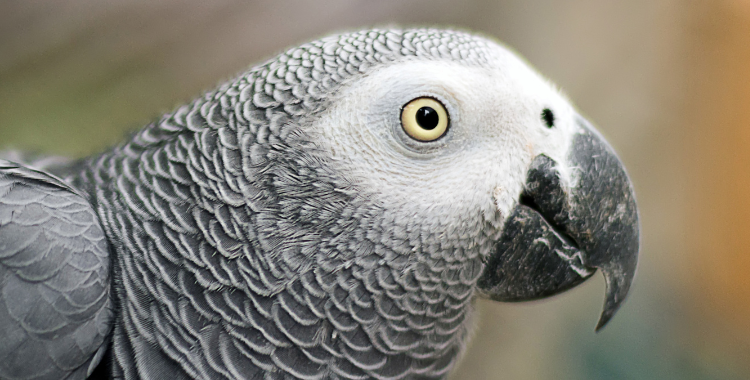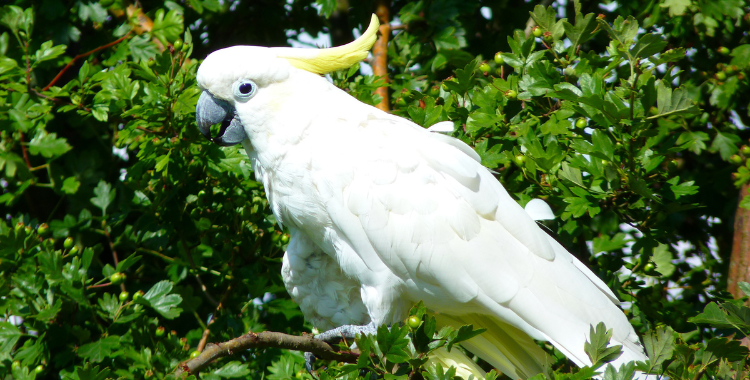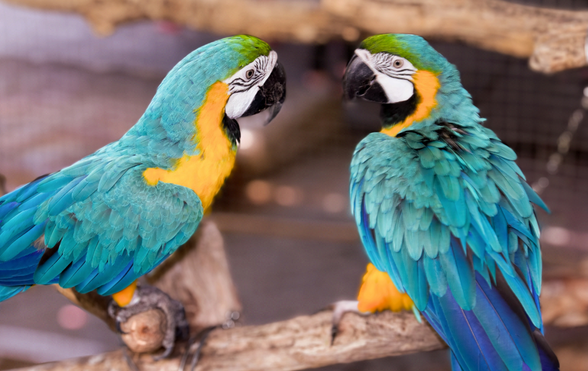From blushing to purring, do you really know what your parrot is telling you? Expert, Dorothy Schwarz explores parrots’ body language and what different actions mean.
Thought about parrot insurance? Get a quote for up to £5,000 of vet fee cover, death and theft cover | We’ve been insuring exotic pets since 1996 | Check out our customer reviews on Feefo.
Click the link to skip to content: Opening wings | Blushing | Head bobbing | Standing on one leg | Fluffing cheek feathers | Beak grinding | Purring | Preening | Eye pinning | Tail lifting | Sickness | Dropping wings | Feather puffing
To communicate animals use their bodies, their posture, their voices, their hair, fur or feathers.
Most animals are more honest than humans, who’ll often say one thing when they mean another, or hide fear by adopting a bold posture.
However, time spent reading your bird’s body language, what your parrot means when they grind their beak, or flares their tail, will be time well spent.
The more you can communicate across species, the better your relationship with become.
Here are a few guidelines taken from my own flock and from the literature on the subject.
To start with some cheerful and heart warming behaviour.
Also written by Dorothy Schwarz: Parrot food and diet ideas
Why do parrots open their wings?
They’ll be stretching out one wing and looking towards you.
They may curl up the claw and stretch the leg on the same side of the stretched out wing.
The parrot is saying with a movement, not words, ‘Hi, pleased to see you again.’
Thought about parrot insurance? Get a quote for up to £5,000 of vet fee cover, death and theft cover | We’ve been insuring exotic pets since 1996 | Check out our customer reviews on Feefo.
Alternatively you can call our team on 0345 982 5505
Why do parrot fluff up their feathers and wag their tail?
Another greeting signal is feathers fluffing up and tail wagging.
A parrot that rapidly flips their tail is most likely happy to see you.
A species like a caique might even start bopping along the perch.
The more sedate, larger parrots show pleasure more discreetly.
Another sign of affection is the parrot who flies straight to your arm before you have even called her.
Birds show much curiosity if they are at ease and unafraid.
Going into the bird room first thing in the morning, the birds make eye contact, lean forward and come closer.
How can you train your parrot? Dorothy Schwarz shares her knowledge.
 Some parrot species can blush just like humans
Some parrot species can blush just like humans
Why do parrots blush?
Mina, my military macaw, (Ara militaris) blushes whenever anything pleases. amuses or frightens her. That’s a species trait.
Other macaws do blush but less so.
Benni, my Blue and Yellow macaw’s (Ara arucana) first blush was at ten weeks old during his first vet visit. He was nervous. Now he blushes slightly – usually for pleasure when he sees a favoured person.
Signals from body posture exhibit plenty of uniformity, but you’ll will find differences between species and smaller differences between individual members of one group.
Thought about parrot insurance? Get a quote for up to £5,000 of vet fee cover, death and theft cover | We’ve been insuring exotic pets since 1996 | Check out our customer reviews on Feefo.
Alternatively you can call our team on 0345 982 5505
Why do parrots bob their heads up and down?
Head-bobbing is baby bird behaviour.
Chicks bob their heads asking for food but it still can continue into adulthood to show general enthusiasm.
Head bobbing is also a sign of mating behaviour
When the parrot wants you to pet their head, they will drop it.
Why does my parrot quiver?
When cockatoos want you to pet their heads, they may lay their leads on your breast and quiver.
Quivering can also be a sign of mating behaviour.
Why do parrots stand on one leg?
Standing on one leg is a general sleeping posture, but can be also used in the day.
It’s a sign of relaxation, and also helps to reduce the amount of heat lost from the un-feathered part of their body.
You’ll find your parrot may stand on one leg with the other tucked up.
Other signs of relaxation are the body feathers held loosely – no tension can be seen.
 Cockatoos can fluff their cheek feathers when content
Cockatoos can fluff their cheek feathers when content
Why do birds fluff their cheek feathers?
Cockatoos have a charming habit of fluffing their cheek feathers over their beak, almost hiding it.
When they do that, you know they’re content.
When I say ‘hello’ to the African Greys or the cockatoos, they’ll often clack their beak silently in response which appears to me a way of saying ‘hello’ in their language.
Why do birds grind their beaks?
Before they sleep, you may hear a grinding noise.
The bird is gnashing its beak but this isn’t temper. No one knows for sure but we assume it is a sign of self-trimming of the beak.
Why do parrots purr?
Purring is a sign of affection, however it’s quite a rare sound. None of my birds have ever purred.
Purring is not to be confused with a low growl that you may hear from a frightened bird.
Jayne Boulton, who keeps a flock of nine pet parrots, has an excellent rapport with Ronnie, a seven-year-old grey who has lived with her since she was a youngster.
Jayne says, ‘She purrs when she is sitting on my chest and I cover her over with a cover and we have snuggles.’
How can you save money on parrot toys? Check this out…. 10 ideas for homemade parrot toys
Why do parrots preen?
Only a relaxed parrot preens, because to do this, they must bury their head in their feathers or under their wing and must be confident that the environment is safe enough to do so.
In the wild, parrots only preen if no predators are nearby. In captivity, they’ll only preen when they trust everyone in the immediate vicinity.
The parrots’ preen gland is located just above the tail so parrots may be seen rubbing their beak enthusiastically on that spot to obtain preen oil on their beaks to rub along their feathers.
It’s worth noting that not every species has a preen gland.
When you have two parrots together, once they are close friends, they preen one another. Of course, bonded pairs spend a lot of time preening one another.
Sometimes the preener becomes over-enthusiastic and actually plucks bare spots onto his or her companion.
Parrot buddies can be opposite or same sex. They can be same species or different ones. Or the parrot can choose one member of the household for their best mate.
My two Greys, Artha and Casper, are more bonded to me than to each other. Both will preen my eyelashes but not one another’s.
Parrots often preen their owners. If your parrot gently chews on your hair, beard, ear, or shirt, this is likely what they’re doing. It means the parrot truly likes you!
Why do parrots fluff their feathers?
The Greys show excitement in various ways.
Wings stretch out in greeting. Feathers fluff up.
It is difficult to describe the exact difference between feathers fluffed up in with pleasure and feathers fluffed up in aggressive mode.
Whenever I’ve been away for a day, Artha greets me with her feathers fluffed up. Perdy the Lesser Sulphur Crested raises her crest. Bobo the umbrella will raise her crest and dance.
Parrots can also fluff their feathers when they’re ill.
Why do parrots eyes pin?
Eye pinning is that amazing sight when the pupils dilate and contract. Some parrots do this when they’re excited about something they like, such as a new toy or good food.
But a parrot whose pupils are pinning in and out is excited and that excitement may slide into bite mode.
It is said that birds who talk pin their eyes – but not all parrots who pin their eyes will talk.
Why is my parrot crouching, lifting her tail and wagging her tail?
This can be a sign that your bird wants to poop.
When you see this posture and before the bird poops you can take them to the desired place and use a key word or gesture.
I’ve never managed to potty train the Greys indoors but when they are on an outing, wearing their harnesses, they will ‘go potty’ on request if I time it right and observe them closely.
Friends have successfully potty trained their parrots; it can be done.
Signs of sickness in a parrot
If your bird is sick they’ll:
- Show no sign of alert interest
- Won’t make eye contact
- They’ll keep both of their feet on their perch
- Their feathers will be fluffed up
- Their tail will be straight down and it may be wagging.
- Their body posture will also be slumped
- They may be fluffed up at the bottom of their cage
- And they won’t be eating
They may also exhibit other more familiar signs such as wheezing and sneezing.
If your bird exhibits these signs you should them to see an Avian vet.
Your vet won’t mind if it is a false alarm. Early intervention is truly important for parrots’ ailments since they will often hide symptoms.
Why do parrots droop their wings?
Wings drooping or dropping in a listless bird, indicates illness.
It can also indicate mating behaviour, which is discussed further in this article.
I have had aged rescue birds die in the aviary. Their illness showed up in their body posture. Fluffed up and generally on the ground.
Bigboy, an elderly Timneh rescue, spent eight happy months in the aviary. But in the ninth month, his wings were drooping for a week. The vet advised watching him.
There was nothing to be done. Bigboy flew to me one morning and died in my arms. He had a stroke.
Why do parrots growl?
A frightened parrot may growl.
Their feathers will be slicked tight to their body, there’ll be no eye contact, and thier feathers pulled in.
They may also growl and try to escape and fly away. If unable to fly or escape the threatening hands, a bite might ensue.
Casper Grey for some unknown reason fears horses. When he is close to one, he exhibits all the signs of fear and growls loudly.
I have heard fearful birds growl or hiss. Fear of horses does not seem to be an instinctive parrot fear because Artha Grey used to ride on the pommel of my saddle.
And Benni has been known to buzz the horses that graze in the next field, land on one’s back and swoop away.
It’s worth observing surroundings and any potential triggers in order to understand any fears your parrot may have.
Why do parrots puff up their feathers?
A bird puffing up their feathers can be a sign of fear, aggression, a friendly or even a mating signal.
You need to know your bird well to know which it is.
Signs of fear and aggression can get confused as fear may slide into aggression.
An aggressive bird enlarges their body as much as possible.
When my macaw Benni’s parents were incubating their eggs, the cock bird would spread his wings, appear to double his size and open his beak in a menacing fashion. He looked scary.
Those species with crests raise them. And angry birds can shriek or scream depending on species.
Bites are not that hard to avoid, birds generally give plenty of signs.
A cock Amazon will double in size, pin his eyes, fan his tail and show you that he intends to guard his hen to the death.
If I ask my parrot, Artha to step up from a perch and she slicks her neck feathers down and sidles to the other end, I know she’s saying, ‘Not now.’
Ignoring signals may easily lead to escalation and an eventual bite.
Signs of mating behaviour
Your parrot’s body language will give clear signals.
Head bobbing, regurgitating, wings held out quivering and wing drooping can be part of a mating dance.
The hen may crouch lower on the perch and waggle her tail suggestively. Hens can even whine with desire.
When a pet parrot, especially cockatoos, shows mating behaviour to a human mate, you must avoid over stimulation by stroking and give the bird enough space and activities to try and turn his or her mind to other behaviours.
The majority of unwanted mating behaviours occurs in certain seasons.
If it is uncontrollable, you may need to confine an amorous Amazon to their cage until their hormones subside.
If your parrot is displaying mating behaviour to its mate and you are anxious for chicks these are positive signs.
But should your female cockatoo be panting and quivering next to her chosen human mate, someone may be in line for a bite.
An amorous cockatoo can fly at anyone else or even bite the chosen person to get them to avoid the presence of a rival.
Why do parrots regurgitate?
Regurgitating partially chewed food is not vomiting but wild bird behaviour between a bonded pair; it is the method that parent birds use to feed their young.
When your bird regurgitates on your hand, he or she is paying you a compliment. Just ignore the behaviour and try to distract the amorous creature with an alternative behaviour.
Just avoid stroking or petting that mimics mating behaviour. Full body stroking of pet parrots is something for carers to avoid.
If you’re ever unsure about the difference between regurgitating and vomiting or other signs of illness accompany this behaviour, we advise consulting with a vet.
Why do parrots scratch the floor?
Greys in particular do this because digging is part of their natural wild behaviour.
It can be a bit disconcerting. African Greys, and sometimes other parrots will dig up the newspaper or linings on the cage bottom like a hen in the farm yard.
And if you’re unlucky, a parrot may do the same to your carpet.
If you don’t mind the mess, you can give your Grey a sandbox to play in.
My aviary birds, like Rock Pebblers, kakariki and Princess of Wales parakeets, will scratch on the ground so will the cockatoos.
What about our body language?
How should we approach our parrots?
Calmly and quietly. As our eyes are set in the front of our heads like tigers or owls, we can resemble predators that they instinctively fear.
With a shy or frightened bird, simply looking at them sideways is less threatening.
One long term parrot expert has told me that winking works well. I haven’t tried it yet, you may like to try it.
We complain of parrots’ shrieks. Do they like our voices?
Yelling at a screaming bird instead of encouraging them to decease simply reinforces it.
Birds love noise and cannot easily distinguish between, ‘Wow, how clever, wonderful!’ and ‘Stop that, you horrible nuisance!’
Shushing isn’t a good idea. I’ve seen with my Greys that a hiss upsets them.
A hiss is like a shushing sound. They’re born with a fear of snakes so we shouldn’t imitate snake-like behaviour.
Instead of shushing, speaking quietly and calmly produces better results.
On the other hand, a socialised bird will enjoy seeing you dance, hearing you sing and joining in laughter.
With a new or nervous bird – going up to a bird’s cage with outstretched finger can seem aggressive to a bird.
Your finger can represent a beak and be seen as a threatening gesture.
Approach a bird sideways and keep a good 30 cm distance between you until you are friends. As I am sure you will be.
Thought about parrot insurance? Get a quote for up to £5,000 of vet fee cover, death and theft cover | We’ve been insuring exotic pets since 1996 | Check out our customer reviews on Feefo.
Alternatively you can call our team on 0345 982 5505
Don’t miss out!
Sign up for our FREE monthly newsletter full of interesting content! And it’s spam free.
* indicates required field

